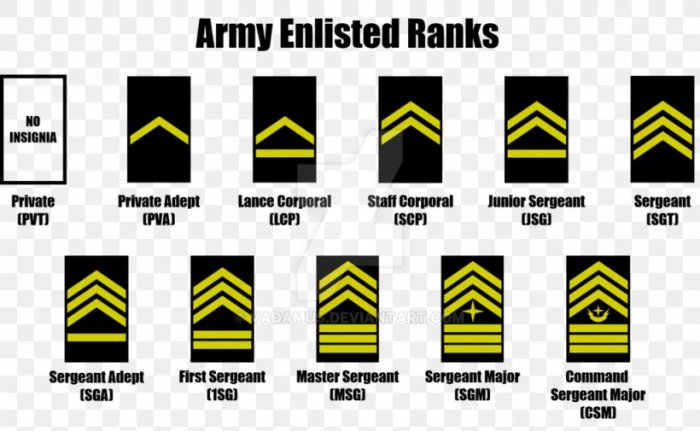Jrotc ranks lowest to highest – Embark on a journey through the ranks of JROTC, from the entry-level cadet to the esteemed commissioned officer. Our comprehensive guide unveils the responsibilities, insignia, and promotion pathways for each rank, providing an insider’s perspective into the hierarchical structure that shapes this esteemed program.
JROTC fosters leadership, discipline, and citizenship, and its ranking system plays a pivotal role in nurturing these qualities. Cadets ascend through the ranks, honing their skills and assuming greater responsibilities as they progress.
Cadet Ranks: Jrotc Ranks Lowest To Highest
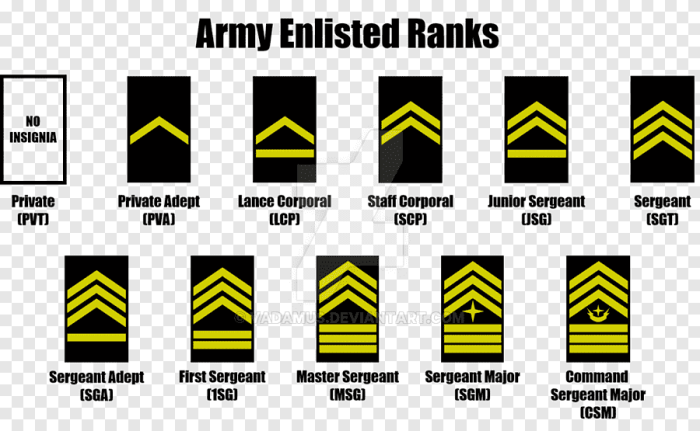
Cadets in JROTC progress through a series of ranks, each with its own responsibilities and insignia. The lowest cadet rank is Cadet Private.
Cadet Private, Jrotc ranks lowest to highest
Cadet Privates are the newest members of the JROTC program. They are responsible for learning the basics of military drill and discipline, as well as the JROTC mission and values. Cadet Privates wear a simple uniform with no insignia.
Non-Commissioned Officer (NCO) Ranks
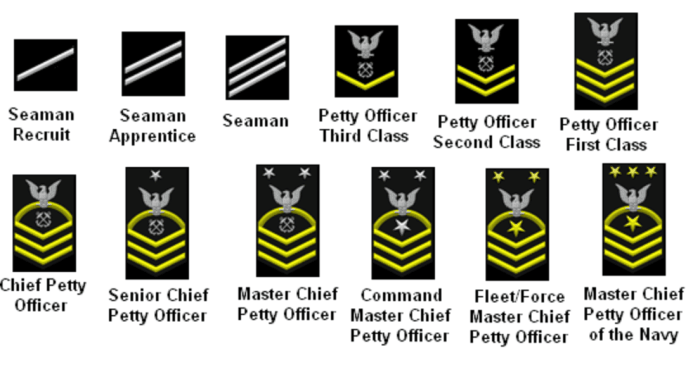
In JROTC, Non-Commissioned Officers (NCOs) play a crucial role in leading and guiding their fellow cadets. NCO ranks are hierarchical, with each level carrying specific responsibilities and expectations.
Corporal (CPL)
- The lowest NCO rank, CPLs are responsible for basic leadership and guidance within their squads.
- They assist in training and supervising lower-ranking cadets.
- CPLs are often the first point of contact for cadets with questions or concerns.
Sergeant (SGT)
- SGTs are the backbone of JROTC leadership, responsible for managing and mentoring their platoons.
- They provide guidance and support to lower-ranking NCOs and cadets.
- SGTs play a key role in organizing and conducting training exercises.
Staff Sergeant (SSG)
- SSGs are senior NCOs who provide leadership and support to company-level units.
- They assist company officers in planning and executing training programs.
- SSGs are responsible for mentoring and evaluating lower-ranking NCOs.
Promotion to NCO Ranks
Cadets are promoted to NCO ranks based on their leadership skills, academic performance, and dedication to JROTC. The promotion process typically involves:
- Nominations from instructors and peers.
- Interviews and evaluations.
- Demonstrated leadership abilities.
Commissioned Officer (CO) Ranks
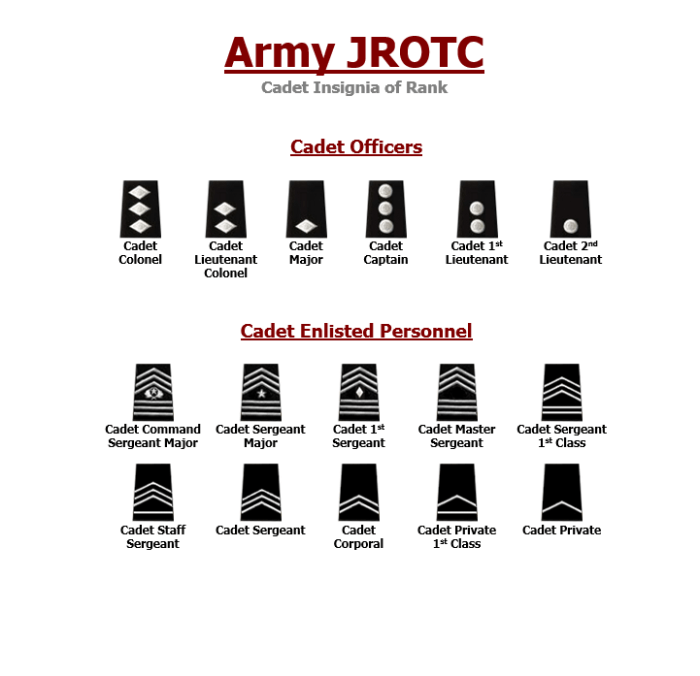
Commissioned Officer (CO) ranks in JROTC represent the highest level of cadet leadership and authority. These ranks are typically held by senior cadets who have demonstrated exceptional leadership skills, academic excellence, and a commitment to the JROTC program.The CO ranks in JROTC, beginning with the lowest, are:
Second Lieutenant
- Second Lieutenants are the lowest-ranking COs in JROTC.
- They are responsible for leading and supervising small groups of cadets.
- Second Lieutenants are typically appointed by the battalion commander or instructor and serve as platoon leaders or assistant platoon leaders.
First Lieutenant
- First Lieutenants are senior to Second Lieutenants and are responsible for leading larger groups of cadets, such as companies or platoons.
- They are also responsible for assisting the battalion commander and other senior officers with various tasks and duties.
Captain
- Captains are the highest-ranking COs in JROTC and are typically appointed by the school principal or other senior school officials.
- They are responsible for leading and managing the entire JROTC battalion and are the primary representatives of the program to the school and community.
Requirements and Procedures for Attaining CO Ranks
To attain a CO rank in JROTC, cadets must meet certain requirements and follow specific procedures:
- Cadets must be in good academic standing and have a record of good conduct.
- They must demonstrate strong leadership skills and a commitment to the JROTC program.
- Cadets must complete a rigorous training program and pass a series of assessments to qualify for CO ranks.
- The battalion commander or instructor typically nominates cadets for CO ranks based on their performance and potential.
- The school principal or other senior school officials then approve the appointments.
Cadet Leadership Positions
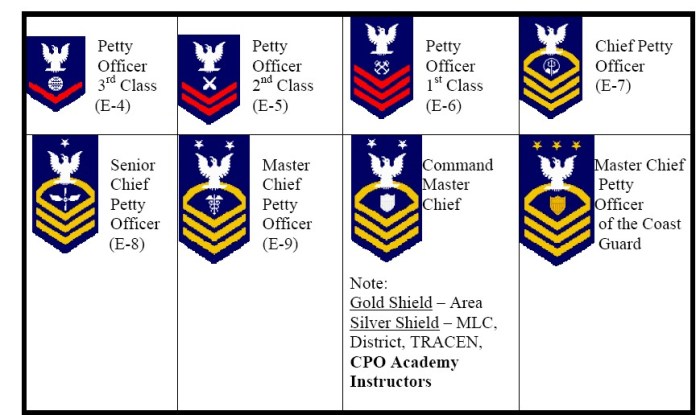
Cadet leadership positions within JROTC offer cadets opportunities to develop their leadership skills, gain valuable experience, and make a positive impact on their unit. These positions are typically held by cadets who have demonstrated strong leadership potential and a commitment to the program.Cadets
can qualify for leadership positions by meeting specific criteria, such as maintaining a high grade point average, participating in extracurricular activities, and demonstrating a strong work ethic. They must also complete a leadership application and interview process.Once selected, cadets are assigned to specific leadership positions based on their qualifications and interests.
These positions include:
- Cadet Commander: The Cadet Commander is the highest-ranking cadet in the unit and is responsible for the overall leadership and management of the cadet corps.
- Cadet Executive Officer: The Cadet Executive Officer assists the Cadet Commander in the day-to-day operations of the unit and is responsible for ensuring that all orders and directives are carried out.
- Cadet Adjutant: The Cadet Adjutant is responsible for maintaining the unit’s records, correspondence, and other administrative duties.
- Cadet Operations Officer: The Cadet Operations Officer is responsible for planning and executing training exercises and other unit activities.
- Cadet Training Officer: The Cadet Training Officer is responsible for developing and delivering training programs for the unit.
- Cadet Logistics Officer: The Cadet Logistics Officer is responsible for managing the unit’s supplies and equipment.
- Cadet Morale Officer: The Cadet Morale Officer is responsible for planning and executing activities that promote unit morale and esprit de corps.
Cadet leadership positions are an excellent way for cadets to develop their leadership skills, gain valuable experience, and make a positive impact on their unit. These positions are highly competitive, but they are also extremely rewarding.
As we navigate the ranks of JROTC from lowest to highest, it’s important to remember the significance of precision. Just as we strive for accuracy in our drills, let’s turn our attention to a mathematical conversion. If you’re wondering how to express 71/1000 as a decimal, follow this handy link for a step-by-step guide.
Returning to our JROTC ranks, we continue our journey towards the pinnacle of leadership and excellence.
Rank Structure Comparison
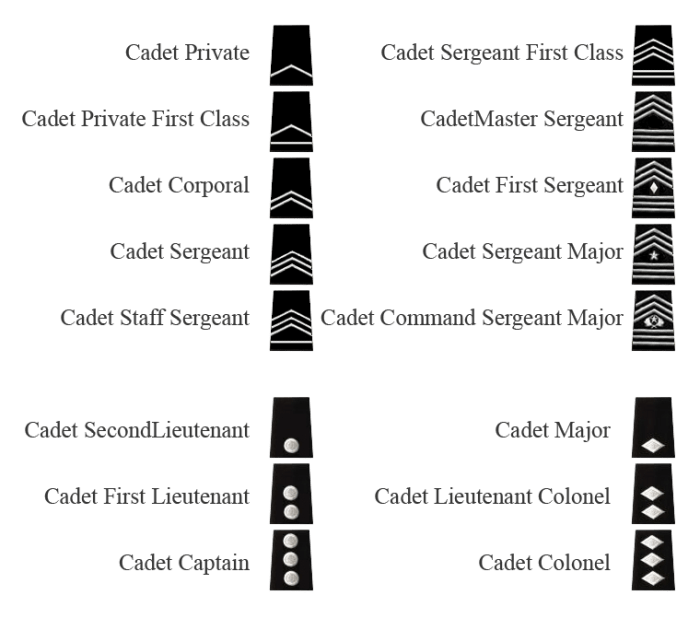
The JROTC rank structure consists of three main categories: Cadet Ranks, Non-Commissioned Officer (NCO) Ranks, and Commissioned Officer (CO) Ranks. Each rank has its own insignia, responsibilities, and promotion requirements.
Cadet Ranks
- Cadet Private (CP): Entry-level rank, no insignia.
- Cadet Private First Class (PFC): First promotion, single chevron.
- Cadet Corporal (CPL): Two chevrons, responsible for leading small teams.
- Cadet Sergeant (SGT): Three chevrons, responsible for larger teams and assisting NCOs.
Non-Commissioned Officer (NCO) Ranks
- Cadet Staff Sergeant (SSG): Three chevrons with one rocker, supervises multiple teams.
- Cadet Sergeant First Class (SFC): Three chevrons with two rockers, senior NCO responsible for larger units.
- Cadet Master Sergeant (MSG): Three chevrons with three rockers, highest NCO rank, responsible for training and advising.
Commissioned Officer (CO) Ranks
- Cadet Second Lieutenant (2LT): Entry-level officer rank, one gold bar.
- Cadet First Lieutenant (1LT): Two gold bars, responsible for larger units and training cadets.
- Cadet Captain (CPT): Three gold bars, highest CO rank, responsible for leading the entire JROTC unit.
Similarities and Differences
All three rank structures share the principle of increasing responsibility and leadership with higher ranks. However, there are some key differences:
- Promotion Requirements:Cadet ranks are typically based on time in service and performance, while NCO and CO ranks require additional training and leadership experience.
- Authority:NCOs have more authority over cadets than COs, who primarily provide guidance and training.
- Insignia:Cadet ranks use chevrons, while NCO ranks use rockers and CO ranks use gold bars.
Commonly Asked Questions
What is the lowest cadet rank in JROTC?
Cadet Private
What are the responsibilities of a Cadet Sergeant Major?
The Cadet Sergeant Major is the highest-ranking cadet in a JROTC unit and is responsible for assisting the commanding officer in all aspects of unit operations.
How do cadets earn promotions?
Cadets are promoted based on their performance, leadership skills, and knowledge of JROTC.
